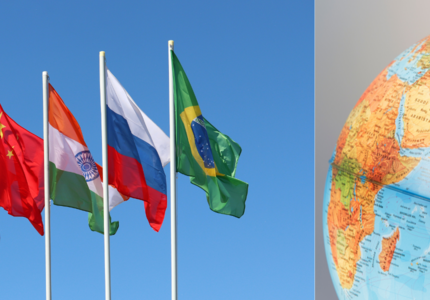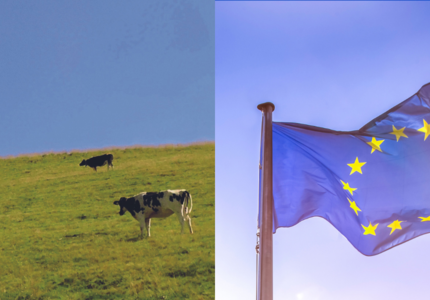The UAE Presidency has emphasised 'Nature' for COP28, with a variety of high-level events and announcements. This focus follows growing momentum on biodiversity and ecosystems within the climate negotiations.1 However, challenges remain in truly responding to the scientific imperative to protect and restore ecosystems and biodiversity while pursuing steep, rapid, and sustained greenhouse gas emissions reductions, without which the Paris Agreement’s and Kunming-Montreal Global Biodiversity Framework (KMGBF)’s goals will be compromised. In advance of COP28 Nature, Land Use and Oceans Day on December 9, we build on IDDRI’s long-standing work on the climate-biodiversity nexus to offer a few insights on priority areas of action at COP28 and beyond.
- 1 With the COP26 Glasgow Pact emphasising the importance of ensuring ecosystem integrity to achieve the UNFCCC’s goals, and the COP27 final decision underlining the “urgent need to address, in a comprehensive and synergetic manner, the interlinked global crises of climate change and biodiversity loss.” The adoption of the KMGBF at CBD COP15 further amplified the call for alignment, with Parties committing efforts to halt and reverse biodiversity loss by 2030 and including a specific target linking climate and biodiversity action (Target 8).
Synergies and trade-offs: better including biodiversity in the Global Stocktake
An ambitious Global Stocktake (GST) COP28 decision is one of the most crucial outcomes expected at Dubai. Mandated to assess the implementation of the Paris Agreement and evaluate collective progress towards global climate goals, including the 1.5ºC goal, the GST’s October Synthesis Report on possible elements for its final decision highlighted both backward and forward-looking aspects. The current draft GST COP28 decision in particular emphasises the importance of protecting ecosystems and addressing biodiversity loss, including by halting and reversing deforestation by 2030.
However, several key elements have not been included in the current draft decision. The backward-looking elements neglect to acknowledge countries’ collective difficulties so far to halt tropical deforestation (primarily due to agricultural expansion), the major source of 4-7 GtCO2 annual land-use change emissions, and a significant driver of biodiversity loss. The absence of questioning the feasibility of Parties’ (over)reliance on land-based carbon-dioxide removal (CDR) in their Nationally Determined Contribution (NDCs) and Long-Term Strategies (LTS) is also notable.2
In the forward-looking sections, key elements that should be included are: explicit reference to the KMGBF for achieving comprehensive & synergistic climate and biodiversity outcomes; recognition of the need of increased finance for developing countries to protect biodiversity; and acknowledgement that to keep the 1.5ºC goal, protecting and restoring nature must come in addition to, rather than instead of, deep emission cuts across all sectors. Throughout, the GST decision should also call for protecting and restoring “ecosystem integrity”–language from the Paris Agreement–rather than the current vague “nature and ecosystems” which could leave the door open to for example monoculture afforestation. Ongoing ministerial (and technical) negotiations on the GST political decision in week 2 of COP28 will show to what extent ecosystem language remains in the text, amidst key tensions on issues such as the inclusion of sectoral goals, and the highly anticipated–and highly contentious–call for an energy transition with fossil fuels phase-out. Colombia and Germany have issued a letter urging countries to include more comprehensively “the role of nature and biodiversity to address the climate emergency” in the GST, however, it is succinct in describing which transition models harm biodiversity more than others.
Aligning biodiversity and climate strategies and plans
Informed in part by IDDRI’s assessment that aligning domestic climate and biodiversity planning is essential for enabling high ambition and action towards the UNFCCC’s and CBD’s global objectives, COP28 for the first time presents a call for countries to connect their NDCs and CBD National Biodiversity Strategy and Action Plans (NBSAPs). At the ministerial event on December 9, Parties should seek to not just call for providing better coherence between mandated instruments–NDCs, National Adaptation Plans (NAPs) and NBSAPS–but also by maximising climate-biodiversity synergies and also minimising trade-offs. This invitation of improved alignment comes at a crucial time, with Parties to the CBD are to communicate their NBSAPs and national targets before COP16 in October 2024, while, informed by the GST, Parties to the UNFCCC will update their NDCs by early 2025.
For key sectors like food systems and agriculture, commitments and action plans in the next round of NDCs (promised by a large number of countries in the early days of COP28 in the Declaration on Sustainable Agriculture, Resilient Food Systems and Climate Action, and informed by the FAO’s 1.5ºC roadmap to be released this coming week) should seek highest ambition for climate and biodiversity, to be reflected across countries’ NBSAPs, LT-LEDS, NAPs and UN Convention to Combat Desertification (UNCCD) National Action Plans. A still under-explored and promising avenue for alignment and constituency across plans and strategies is encouraging energy and food demand management: our IDDRI study crossing IPCC and IPBES reports, and the IPCC-IPBES co-sponsored workshop report find these options offer major win-win opportunities for climate and biodiversity, as well as ensuring resilience in food and energy security.
Two additional promising avenues for alignment IDDRI has been calling for, but which remain under-explored at COP28, are mainstreaming biodiversity within Parties’ Long-Term Low Emission Development Strategies (LT-LEDS),3 and aligning transparency tools across the Rio Conventions, including those related to the UNCCD.4 Better integrating biodiversity within LT-LEDS could help Parties avoid getting locked-in to pathways incompatible with reaching climate, biodiversity and sustainable development goals, such as those posed by large-scale carbon dioxide removal (CDR), and inform more integrated and coherent medium-term climate and biodiversity policymaking (as related to NDCs and NBSAPS).
Ensuring biodiversity-positive climate finance that does not undermine the 1.5ºC
The challenges posed by climate change and biodiversity loss point to the need for a major paradigm shift within international finance strategies. Various reports5 emphasise the need for a recalibration of financial practices (public and private) to address these crises; this is also acknowledged in climate and biodiversity global frameworks and targets.6 CBD COP15 introduced an approach advocating for the alignment of all financial flows with international biodiversity targets, which focuses on reducing harmful subsidies and incentives, generating more resources from diverse sources, and enhancing resource use efficiency. Critical to this shift is the need to strengthen the alignment between climate and biodiversity finance.
Complex discussions are ongoing on how to best deliver flows of funds from the Global North to the Global South, including operationalising and earmarking additional funds for climate, biodiversity, and development projects. While various funds and entities7 specialise in distinct areas, addressing these issues in siloes is counterproductive and thus requires coordinated action. This in turn necessitates considering macroeconomic challenges as well as specific national situations.
COP28 is viewed as an important rendez-vous for advancing the reform of the international finance architecture (IFA). While discussions on climate change and its impacts on debt distress are prevalent, biodiversity is often absent from these conversations–except for the question of biodiversity credits. This requires further consideration, a promising avenue being the launch of the Global Expert Review on Debt, Nature, and Climate, which is set to report back at COP29.
Country packages and country platforms for both climate and biodiversity (JETPs on energy, Positive Conservation partnerships or Forest and Land Use Investment Partnerships on forests) are another avenue that may offer a targeted approach to addressing major issues at the country level by concentrating donors’ intervention on a transformation plan. Attention should be directed at drawing lessons from these pilot projects, ensuring inclusiveness, country ownership, and participation by Indigenous Peoples and Local Communities (IPLCs) and civil society. Their connection with the IFA reform and their accountability and link with respective UN-level fora are crucial. The strategic approach of ‘do not harm’, ‘do more’, and ‘do better’ is imperative in development finance, aligning with both climate and biodiversity objectives. Financial sectoral and socio-economic transformations that are low-carbon and nature-positive should prevent future costs and impacts, ensuring subsidiary and additional actions for biodiversity and restoration. More recently, there have also been proposals to integrate biodiversity and ecosystems in the discussions on loss and damage finance, which will be able to explored further now that the new loss and damage fund has been operationalised in the first week of COP28.
Finally, COP28 has seen a flurry of voluntary announcements related to carbon markets. Their integrity must be questioned, especially when it comes to deals such as the ‘Blue Carbon’ recent deals to purchase large swaths of land in African countries to provide large-scale offsetting for ongoing fossil-fuel emissions, in contradiction with the science which is clear that keeping the 1.5ºC limit requires steep emission declines and biodiversity protection. This emphasises the need for greater scrutiny and stricter regulations. The discussion around the Paris Agreement’s Article 6, ongoing in the second week of COP28 and beyond, need to focus on transformative and equitable financial solutions, thus avoiding questionable offsetting schemes and applying environmental and social integrity. New concepts such as Brazil’s Tropical Forest Forever fund which calls for paying for hectares of standing forests via contributions from sovereign funds and other companies, raise interesting ideas for going beyond carbon offsets, yet also raise questions of implementation, and of better connecting payments for ecosystem services–as suggested by IDDRI–within a co-investment for sustainable development approach that enhances sound environmental policies to address the underlying drivers of biodiversity loss.
Key steps towards Brazil’s COP30
The international biodiversity and climate agendas set significant milestones for the coming years. The CBD COP16 will emphasise aggregating collective ambition within NBSAPs. Simultaneously, Parties to the UNFCCC will begin preparing updated NDCs to be submitted in 2025. Anticipating guidelines to include principles and key sectoral transformations for climate and biodiversity before COP29 is essential. Following the submission of both NBSAPs and NDCs, an assessment of joint ambition for climate and biodiversity could inform COP30, which is expected to witness a significant push, particularly driven by the Brazilian government’s efforts, elevating rainforests and deforestation high on the international agenda. This emphasis underscores the urgency of protecting vital ecosystems and biodiversity, emphasising the need for high-level political packages dedicated to biodiversity finance beyond climate offsets–which needs to be set as a key political priority in the run-up to COP30.
Scientific collaboration between the Intergovernmental Science-Policy Platform on Biodiversity and Ecosystem Services (IPBES) and the Intergovernmental Panel on Climate Change (IPCC) is also crucial. At the upcoming Assessment Report 7 (AR7) scoping session in January 2024, Parties that champion climate and biodiversity must put words to action by calling on the IPCC AR7 to mainstream biodiversity considerations, in particular through Working Group III Report, and emphasising the sustainability limits of land-based CDR strategies.
- 2 The recently updated Land Gap Report finds countries plan to use 1.2 billion hectares (equivalent to global cropland areas) by 2060 (https://landgap.org/downloads/2023/Land-Gap-Report_2023-Briefing_FINAL.pdf) for land-based CDR, roughly half of which imply additional land-use change (afforestation or reforestation, likely mostly via monocultures); largest land pledges coming from high-income fossil exporting countries (USA, Russia, Saudi Arabia, Canada).
- 3 Note that the CBD does not call for the development of biodiversity long-term strategies.
- 4 IDDRI suggested in 2021 various key principles for aligning climate and biodiversity ambition and action. See: A. Deprez et al., Aligning high climate and biodiversity ambitions and action in 2021 and beyond: why, what, and how (https://www.iddri.org/en/publications-and-events/study/aligning-high-climate-and-biodiversity-ambitions-and-action-2021-and).
- 5 For instance: Deutz, A. et al. (2020). Financing Nature: Closing the global biodiversity financing gap. The Paulson Institute, The Nature Conservancy, and the Cornell Atkinson Center for Sustainability; Songwe V, Stern N, Bhattacharya A (2022). Finance for climate action: Scaling up investment for climate and development. London: Grantham Research Institute on Climate Change and the Environment, London School of Economics and Political Science.
- 6 Article 2.1c of the Paris Agreement and Goal D, Targets 14, 15, 18 & 19 of the KMGBF, and COP15’s resource mobilisation strategy.
- 7 Such as the Green Climate Fund (GCF), the Global Environment Facility (GEF), the recent Global Biodiversity Framework Fund (GBF Fund), the upcoming Loss and Damage Fund, and other development actors such as Multilateral Development Banks (MDBs).






